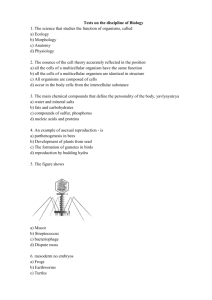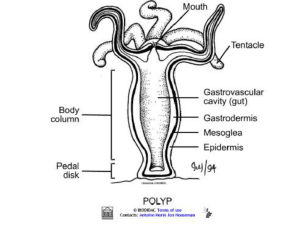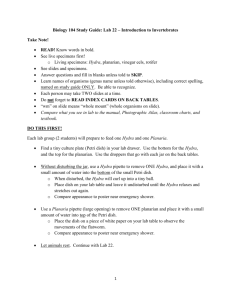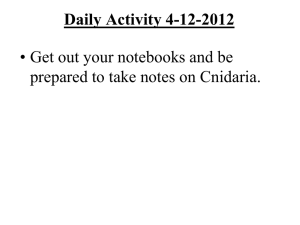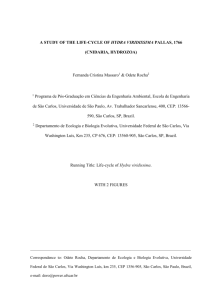Worksheet for Morgan/Carter Laboratory #18 “Animals I – Porifera
advertisement
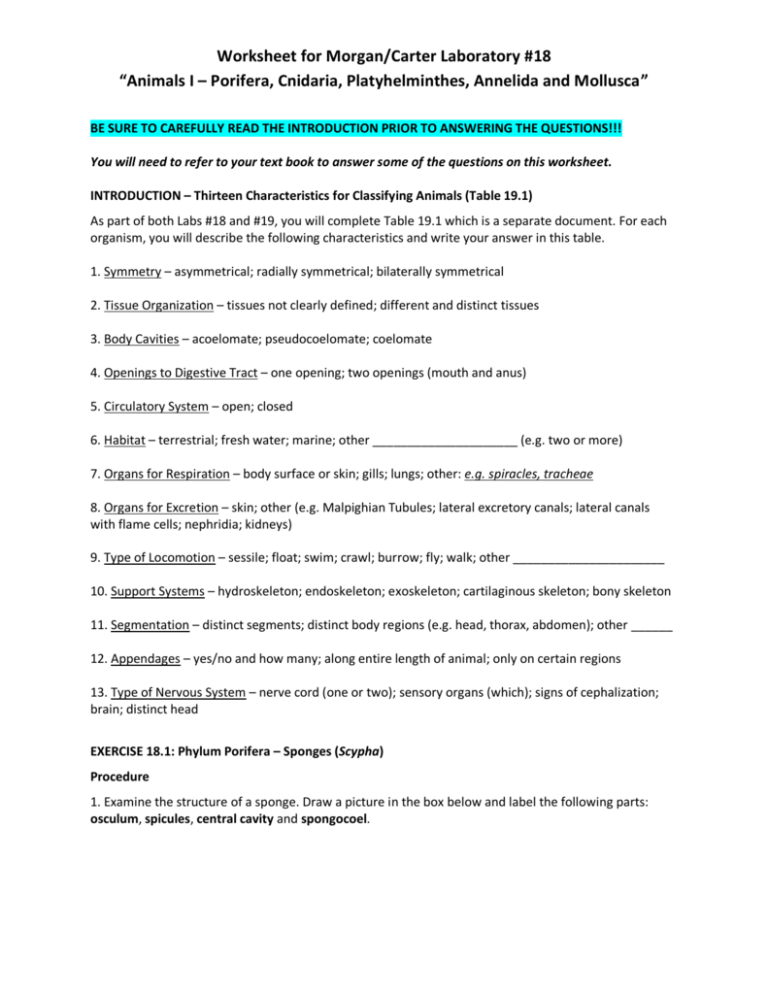
Worksheet for Morgan/Carter Laboratory #18 “Animals I – Porifera, Cnidaria, Platyhelminthes, Annelida and Mollusca” BE SURE TO CAREFULLY READ THE INTRODUCTION PRIOR TO ANSWERING THE QUESTIONS!!! You will need to refer to your text book to answer some of the questions on this worksheet. INTRODUCTION – Thirteen Characteristics for Classifying Animals (Table 19.1) As part of both Labs #18 and #19, you will complete Table 19.1 which is a separate document. For each organism, you will describe the following characteristics and write your answer in this table. 1. Symmetry – asymmetrical; radially symmetrical; bilaterally symmetrical 2. Tissue Organization – tissues not clearly defined; different and distinct tissues 3. Body Cavities – acoelomate; pseudocoelomate; coelomate 4. Openings to Digestive Tract – one opening; two openings (mouth and anus) 5. Circulatory System – open; closed 6. Habitat – terrestrial; fresh water; marine; other _____________________ (e.g. two or more) 7. Organs for Respiration – body surface or skin; gills; lungs; other: e.g. spiracles, tracheae 8. Organs for Excretion – skin; other (e.g. Malpighian Tubules; lateral excretory canals; lateral canals with flame cells; nephridia; kidneys) 9. Type of Locomotion – sessile; float; swim; crawl; burrow; fly; walk; other ______________________ 10. Support Systems – hydroskeleton; endoskeleton; exoskeleton; cartilaginous skeleton; bony skeleton 11. Segmentation – distinct segments; distinct body regions (e.g. head, thorax, abdomen); other ______ 12. Appendages – yes/no and how many; along entire length of animal; only on certain regions 13. Type of Nervous System – nerve cord (one or two); sensory organs (which); signs of cephalization; brain; distinct head EXERCISE 18.1: Phylum Porifera – Sponges (Scypha) Procedure 1. Examine the structure of a sponge. Draw a picture in the box below and label the following parts: osculum, spicules, central cavity and spongocoel. Sponge 2.B. Are cells organized into distinct tissues? What is the role of a choanocyte (collar cell)? What would you hypothesize about the movement of oxygen and waste products throughout the sponge and into and out of cells (the mode of transport)? EXERCISE 18.2: Phylum Cnidaria – Hydra (Hydra) Procedure 1. Draw a picture of a Hydra in the box below: Hydra 2. Study a prepared slide of Hydra in cross-section and longitudinal section. Do you see any definite and distinct tissues present? If so, how many layers would you say it has? Given what you now know about embryology, what embryonic layers would you guess give rise to the tissue layers of this animal’s body? Draw a simple picture of a cross-section and longitudinal section in the boxes below. Label the following parts: gastrovascular cavity and gastrodermis (inner layer). Hydra (cross-section) Hydra (longitudinal section) 5. Do you see signs of any skeleton or other body support system? How is its body supported? 6. Recalling the whole organism and observing this cross section, do you see any distinct organs for gas exchange with the environment? 7. Do you observe any special organs for excretion (e.g. kidney, etc.)? 8. Are there any specialized type of cells? If so, what are they and what are their function? EXERCISE 18.3: Phylum Platyhelminthes – Planarian (Dugesia) Draw a picture of a Planarian in the box below. Label the eyespots, auricle and brain. Planarian Procedure 1. Obtain a simple Planarian and use your dissecting microscope to observe it in action. Describe its locomotion (how it moves). What is the position of its head? Does its body appear to contract? As you look at the Planarian, you will see two striking new features with regard to symmetry that you did not see in Sponge or Hydra. How is this body plan different? 3. Examine the body for possible digestive tract openings. How many can you observe (or can you observed them)? 5. Study a prepared slide of a planarian. Do you see a body cavity in the specimen? What word describes this body cavity type? (see Figure 18.2a) a. How many distinct tissues are present? What might this mean about embryonic germ layers? b. What provides body support for this animal? c. How might gas exchange take place in its body? Results In the box below, draw a picture of a cross-section through a Planarian. Label the following parts: epidermis, muscle layer, mesoderm, endoderm, pharynx and pharyngeal chamber Planarian (cross-section) EXERCISE 18.4: Phylum Annelida – Clamworms (Nereis) and Earthworms (Lumbricus terrestris) Lab Study A – Clamworms (Nereis) Procedure 1. Obtain a clamworm and observe its parts. Draw a picture of the clamworm in the box below. Label the following parts: segments, parapodia, setae and sensory appendages. Clamworm (Nereis) 1. How would you describe the symmetry of this animal? 5. Locate the intestine. Do you see the “tube-within-a-tube” body plan? 6. Two muscle layers, one inside the skin and a second lying on the surface of the intestine, might be visible with the dissecting microscope. With these two different muscle positions, what type of coelom does this animal have? 7. Continue your observations with the dissecting microscope and look for blood vessels, especially the large vessel with another on the ventral (anterior, front) of the digestive tract. What do we call this type of circulatory system with blood vessels circulating through closed vessels? 8. Gas exchange must take place across wet, thin surfaces. Do you see any specific organs for gas exchange (e.g. gills or lungs)? How do you think gas exchange takes place? 9. Do you see any kind of skeleton or other form of body support? What would support the body of this animal? Lab Study B – Earthworms (Lumbricus terrestris) Procedure 1. Obtain an Earthworm and observe its parts. Draw a picture of it in the box below. Label the following parts: prostomium, clitellum, brain and ventral nerve cord. Earthworm (Lumbricus terrestis) ►►► Look into the body cavity after making your incision and locate the following parts: blood vessel, heart (lateral blood vessels), pharynx, esophagus, crop (swollen region if the GI tract), gizzard and intestine. 2. Obtain a prepared slide of the Earthworm and look for the following features: a. Locate the thin cuticle lying outside of, and secreted by cells of the epidermis. Recall the habitat in which this organism lives and speculate about the function of the cuticle. b. Confirm you decision about the type of coelem by locating the muscle layers inside the epidermis and also lying on the surface of the intestine near the body cavity. c. Locate the ventral nerve cord, lying on the floor of the coelom, just inside the muscle layer. d. Draw a simple picture of the cross-section through an Earthworm in the box below and label as many parts (from above) that you can locate. Earthworm (Lumbricus terrestis) – cross section EXERCISE 18.: Phylum Mollusca – Clams Procedure 1. Observe the external anatomy of a preserved clam. Can you determine symmetry, body support system and presence or absence of appendages? If so, what are they? 2. Determine the dorsal/ventral; anterior/posterior and right/left regions of the animal. Note that the valves are held together by a hinge called the umbo. The umbo is located dorsally and the valves open ventrally. Hold the clam vertically with the umbo away from your body. The valve in your right hand is the right valve while the valve in your left hand is the left valve. These two valves are held together by two very strong adductor muscles inside the shell. 3. Carefully follow the instructions on how to dissect the clam. (see Figure 18.8 and read steps 3 – 10. Observe the following structures: ■ mantle; ■ anterior adductor muscle; ■ incurrent and excurrent siphons; ■ visceral mass; ■ muscular foot; ■ gills; ■ mouth; ■ anus; ■ heart; ■ true coelem; ■ intestine; ■ ostia; ■ sinuses; ■ nephridia; ■ gonads; ■ digestive gland; ■ stomach 8. Locate the mouth between two flaps of tissue just ventral to the anterior adductor muscle. Look just above the posterior adductor muscle and locate the anus. How is it oriented in relation to the excurrent siphon? 9. What evidence would indicate that this animal is aquatic rather than terrestrial? 10. What type of circulatory system does it have? Draw a picture of the internal cavity of the clam the box below. Clam (inner body drawing) REVIEWING YOUR KNOWLEDGE Be sure you fill-in Table 19.1 for both this lab and M/C #19. ► You may need to refer to your text to help answer these questions. 1. What are the characteristics of sponges that have led scientists to classify them in a group separate from Eumetazoa? 2. What characteristics are used to separate animals into the two groups: protostomes and deuterostomes? 3. Molecular evidence has led taxonomists to group bilaterally symmetrical animals in one of three clades: Deuterostoma, Lophotrochozoa, and Ecdysozoa. Give one distinguishing characteristics of each of these groups other than molecular differences.

